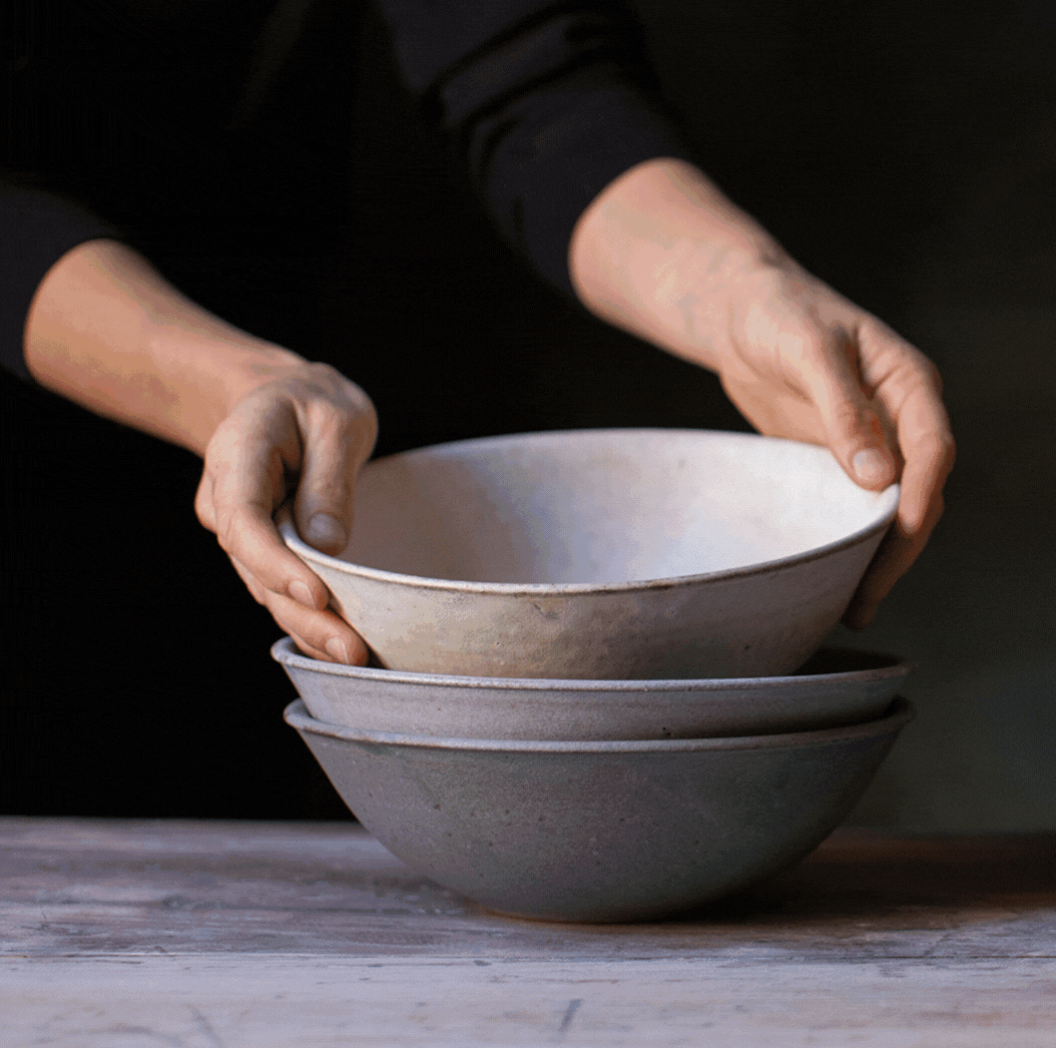In Conversation: Sophie Moran on Finding Your Voice at the Wheel
We chat with Sophie Moran—potter, teacher, and one of our beloved Tuesday evening instructors—to talk about breaking arms, breaking through creative blocks, and the quiet power of making what matters to you.
Sophie, I love starting at the beginning. You came to ceramics in your early twenties, a bit directionless, surrounded by musician friends. What was it about the wheel that made you stay?
Sophie: Most of my friends were ‘musos’ and I couldn’t carry a tune. I went in search of a creative outlet. A few short courses later I ‘discovered the wheel’ in a Melbourne Uni art room and haven’t stopped throwing since.
And then you came to Box Hill TAFE, where we crossed paths. What do you remember about those days?
Sophie: I self-taught for a year or so then undertook a Diploma of Ceramics at Box Hill TAFE where you were one of the tutors, alongside Shane Kent, Sue McFarlane and Brett Robertson. Your approaches were diverse and inspiring. The course gave me the opportunity to find what felt natural to me as a maker and the methodology to progress ideas. Initially I set up a studio/shop in Northcote with two other graduates. From there I’ve moved from studio to studio in the northern suburbs of Melbourne, continuously making and teaching pottery, one way or another, for the past 25 years.
Twenty-five years! When you look at your work now compared to those early days, what’s changed?
Sophie: I have a clearer voice and vocabulary of forms now, while continuing to experiment and play when I can. In the beginning I wanted to try everything, which the TAFE course enabled. I began with a passion for traditional, earthy pottery, moved through a period of highly refined porcelain and now find my work contentedly sitting somewhere in between. Function is always at its core.
Tell me about that shift away from porcelain. I know there was a specific moment.
Sophie: I had a breakthrough moment toward the end of my “porcelain period” where I realised I missed the more expressive nature of stoneware. I wanted to bring my personality back into my work with the benefit of more mature techniques. I remember vividly unpacking a plate from a glaze firing. The making process had been labour intensive—I dried porcelain clay, crushed and weighed it to add a specific amount of stain. I then reconstituted the coloured clay, wedged it and threw a plate. I turned the plate and inlayed fine lines of white porcelain. I turned it again, bisque fired it, glazed it in clear stoneware glaze and popped it in the kiln for its final firing. When I removed it from the kiln I was pleased to see everything had gone according to plan. However, the plate felt lifeless. It reminded me of a cheap melamine plate from the $2 shop. That moment helped me realise refinement and technical expertise were only part of the creative process and that capturing the ‘aliveness’ of the making process is equally important.
That’s such important wisdom for makers at any stage. What advice would you give people just starting out?
Sophie: When you are starting out it is hard not to look at pottery made by others. While observation and emulation is helpful to develop skills, the sooner you look internally for inspiration the better. Exploring personal narratives, and asking yourself what is important to you, will help you find that unique voice. If, in the past, I made what I thought ‘the market’ wanted, it did not sell particularly well. When I make what I want myself, it is more highly sought after. Collectors recognise when your work is honest.
That honesty comes through in everything you do. Though I have to ask—this has been quite a year for you. Can you tell us what happened?
Sophie: In October this year I fell from a ladder while painting my studio wall and unfortunately broke the arm of my dominant hand. This is the first time in my 25 year career that I haven’t been able to pot. Interesting times!
How did you manage?
Sophie: I’m getting by with a lot of help from my friends. Prior to my fall, I had made and bisque fired a large body of work for a new collection. Painter and studio colleague, Beatrix Whardel, kindly offered to help me glaze. I have never had an assistant. My active involvement in all steps of creation is important to me—read control freak—but I knew Beatrix to be patient, attentive to detail, gentle and calm. She has prior ceramic knowledge, yet it was these characteristics that put me at ease. With my instructions and her steady hand we glazed and fired the whole collection, which will be released online in early December. She did a fantastic job.
You’ve always been so thoughtful about the conceptual side of your work. When I think about your pieces, I really admire how you release tableware in collections, bringing surface and form together through a thematic lens. How would you describe your vocabulary of forms?
Sophie: Function is at the heart of my practice so my vocabulary of forms includes the usual suspects—cups, bowls, plates, jars, teapots and vases. I like to work in collections so the pieces relate to each other, be it in shape, surface, tone or scale. I start with a narrative, perhaps a memory from my childhood or a concept or aesthetic that resonates with me, then I explore ways to express my ideas within the forms. In this way pottery provides me with a physical act to explore my thoughts and also creates objects imbued with ideas that can then be passed into the hands of others. To me, pottery is a quietly subversive act for good.
A quietly subversive act for good—I love that. Though I have to say, it’s not always easy to maintain energy and meaning in this work, is it?
Sophie: Oof. I definitely have highs, lows and days when I want to give up. It is not an easy gig. I remind myself that pottery is my way of thinking about how to live and what to live for. It engages my mind and body, connects me with my community and gives me identity and purpose. I also remind myself that I’ve been doing it for too long to give up now and I don’t know how to do anything else. 😉
Do you have a favorite memory from teaching at Slow Clay?
Sophie: Every time I see a student have a breakthrough moment is special. It’s exceedingly heartwarming to see students discover the pleasure pottery can bring. One of my favourite moments was being approached by a young woman and her mother at a market I was participating in. They had done one of my classes together and I remembered them. She was now studying ceramics at a tertiary level and wanted to say thank you for sparking the joy it was bringing her. I was so chuffed!
That’s the ripple effect of good teaching. We’re lucky to have you back with us. Will you be returning to your Tuesday evening class?
Sophie: Yes! I am looking forward to returning to my Tuesday night intermediate class, with two functioning hands, in February 2026. And huge thanks to Mary-Lou Pittard for taking my class for me!
And for those who want to follow your work or catch that December collection drop?
Sophie: I mostly share my work on Instagram @sophiejanemoran and on my website www.sophiemoran.studio. I attempt to give voice to the conceptual ideas behind each collection of tableware I create. The new collection drops in early December—stay tuned! If you would like notification and priority access it is best to subscribe to my emails. I will be hosting one more open studio before the end of the year also.



